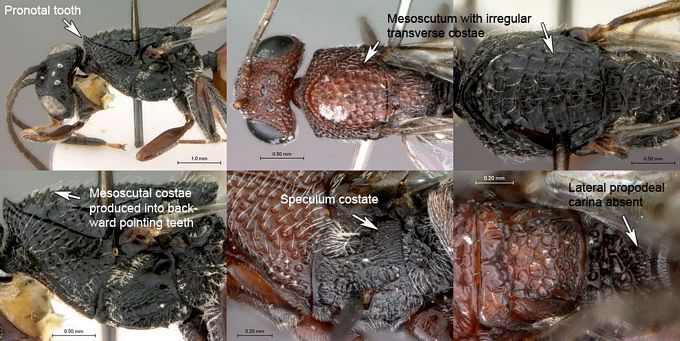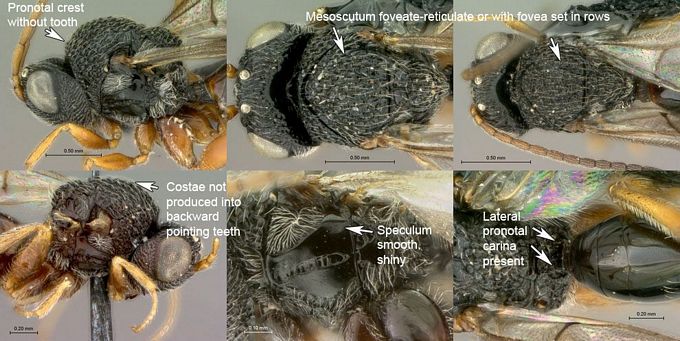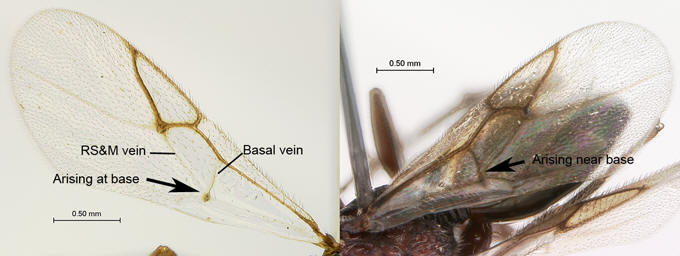
1. Mesoscutum, smooth, shiny with only
remnants of transverse costae. Median mesoscutal impression present, reaching
halfway to anterior margin. The two scutellar foveae each with four subcarinae creating a
transverse row of 10 longitudinally elongate subfoveae. Latero-ventral margin of
pronotum angled where it meets lateral pronotal carina. F1 of antenna shorter
than F2 (Paramblynotus seyrigi species-group) ...
Paramblynotus seyrigi

Mesoscutum foveate-reticulate, or transversely
carinate with foveae set in rows, or with rough discontinuous transverse costae
produced into irregularly raised and slightly backward pointing teeth. Median mesoscutal impression, if present, obscured by sculpture. Scutellar foveae
usually two in number, or less frequently subdivided into a maximum of 6 subfoveae. Latero-ventral margin of pronotum evenly curved. F1 of antenna equal to
or longer than F2 ... 2

2. Pronotal crest gradually raised, medially
forming a conspicuous slightly backward pointing ridge-like tooth. Mesoscutum
with rough discontinuous transverse costae produced into irregularly raised and
slightly backward pointing teeth. Speculum longitudinally costate. Median
propodeal area not delimited by lateral propodeal carinae, posteriorly foveate-reticulate
(Paramblynotus yangambicolus species-group) ... 3

- Pronotal crest flat. Mesoscutum foveate-reticulate
or with continuous transverse carinae with foveae set in rows. Speculum smooth,
rarely longitudinally costate. Median propodeal area distinctly delimited by
lateral propodeal carinae, posteriorly not foveate-reticulate (Paramblynotus
trisetosus species-group) ... 7

3. Forewing with RS+M vein
arising at or very close to base of basal vein (Madagascar) ... 4

- Forewing with RS+M vein arising at basal third
or mid-way up basal vein (Africa) ... 5

4. Head and mesosoma black.
Abdominal tergite 2 (petiole) dorsally sparsely variolate with
confused, weak, longitudinal carinulation; laterally with
strong, widely spaced longitudinal carinae. RS+M, basal vein and
M+Cu1 nebulous. RS+M arising from base of basal vein, this
juncture represented by a pigmented spot. (Female unknown) ...
Paramblynotus behara

- Head pronotum, mesoscutum and scutellum
reddish-brown. Abdominal tergite 2 (petiole) densely longitudinally carinate.
RS+M, basal vein and M+Cu1 distinct. RS+M arising slightly above base of basal
vein. (Female T8 with two excavations, a smaller
circular one surrounding the spiracle and a second larger oval one adjacent to
the first and extending to posterior margin) ...
Paramblynotus zohy

5. Body length about 4 mm.
Body colour entrirely dark. Eyes prominent, protruding
distinctly beyond genae. Median frontal carina almost reaching
clypeus. Antennal scrobes rugose. Speculum distinctly
longitudinally carinate. Upper mesopleuron foveate-reticulate.
Mesoscutellum sloped posteriorly. Wings entirely transparent.
Metasoma somewhat, but not strongly, compressed laterally.
Metasomal T6 almost about the same size as the three preceding
tergites. Metasomal sterna 4-6 entirely covered by sternum 3 ...
Paramblynotus mixtus

- Body length about 6–10 mm. Head and mesosoma
dark, metasoma yellow to brown. Eyes not protruding distinctly beyond genae.
Median frontal carina absent in lower face. Antennal scrobes entirely
longitudinally carinate. Speculum very finely and superficially carinate. Upper
mesopleuron entirely longitudinally costate. Mesoscutellum raised posteriorly,
forming a flat dorsal surface. Forewing evenly ferruginous with darker marginal
cell and a dark narrow strip along anterior-interior margin of the first
submarginal cell. Metasoma strongly compressed laterally. Metasomal T6
distinctly larger than any of the 3 preceding tergites. Metasomal sterna 4-6
exposed, not covered by sternum 3 ... 6
6. Face evenly curved in
lateral view. Genae ventrally strongly expanded posteriorly.
Median mesopleural impression distinct. Lower mesopleuron
densely punctate with pubescence. Apical teeth of metatibia
rounded apically; first metatarsomere 2.0X length of remaining 4
metatarsomeres combined ...
Paramblynotus alveolatus
- Face distinctly raised medially and curved
inward ventrally in lateral view. Median mesopleural impression usually obscured
by extension of longitudinal carinae in upper mesopleuron. Lower mesopleuron
glabrate and sparsely punctate with sparse pubscence. Apical teeth of metatibia
pointed apically; first metatarsomere 1.5X length of remaining 4 metatarsomeres
combined ...
Paramblynotus yangambicolus
7. Head compressed
longitudinally; occiput not concave in dorsal view. Mesoscutum
densely foveate, without transverse carinae ...
Paramblynotus prinslooi
- Head not compressed longitudinally; occiput
distinctly concave in dorsal view. Mesoscutum more or less foveate-reticulate,
with or without transverse carinae ... 8
8. Median frontal carina
absent. T6 of female metasoma the largest and T8 distinctly
exposed. Median propodeal area without a strong transverse
carina ... 9
- Median frontal carina present (may only be
weakly represented between toruli). T6 of female metasoma not always the
largest; if T6 the largest, then T8 is not exposed. Median propodeal area
usually with a strong transverse carina. Occasionally variations occur, but
never come in combination of features as the above collate ... 13
9. Forewing entirely clear ...
10
- Forewing at least ferruginous in marginal cell
... 11
10. Antennae of female with 11
flagellomeres; apical flagellomere less than twice as long as
subapical flagellomere. Pronotal crest medially not raised into
a triangular process. Metasoma black ...
Paramblynotus nigricornis
- Antennae of female with 10 flagellomeres;
apical flagellomere longer than twice as long as subapical flagellomere.
Pronotal crest medially raised into a small but distinct triangular process.
Metasoma brown ...
Paramblynotus claripennis
11. Antennal scrobes
longitudinally carinate in upper part and glabrous in lower
part. Upper mesopleuron glabrous, smooth, shiny. Metasoma black
...
Paramblynotus samiatus
- Antennal scrobes longitudinally carinate
entirely. Upper mesopleuron foveate to rugose. Metasoma brown ... 12
12. Vertex longitudinally
carinate laterally. Pronotal crest medially raised into a small,
distinct rounded triangular process. Scutellar foveae without
submedian carinae ...
Paramblynotus maculipennis
- Vertex foveate-reticulate entirely without
longitudinal carination. Pronotal crest smoothly flat, without triangular
process. Scutellar foveae subdivided by distinct submedian carinae ...
Paramblynotus townesorum
13. Distance between posterior
ocelli at most twice as large as the distance between posterior
ocellus and eye. Metasomal T5 of female normal, T6 the largest;
T7 exposed, almost entirely covering T8 ... 14
- Distance between posterior ocelli at least
three times the distance between posterior ocellus and eye. Metasomal T5 of
female dorsally expanded, being the largest (at least so dorsally); T7 is
largely or entirely covered by T6; T8 exposed ... 28
14. Female flagellum
distinctly thicker toward apex; median flagellomeres not or
slightly constricted toward ends. Antennae with distal
flagellomeres 1–3 black, contrasting to the rest, which are
yellow-orange ... 15
- Female flagellum not distinctly thicker toward
apex; median flagellomeres distinctly constricted toward ends. Antennae yellow
or gradually becoming somewhat darker toward apex, but never with contrasting
colors between distal and proximal flagellomeres ... 19
15. Wings with infuscate patch
covering submarginal and marginal cells and extending distally
slightly beyond vein RS ...
Paramblynotus ruvubuensis
- Wings clear ... 16
16. Metacoxae ventrally
expanded to form a triangular lobular process ...
Paramblynotus coxatus
- Metacoxae ventrally not expanded to form a
triangular lobular process ... 17
17. Antennae with apical 3
flagellomeres black. Antennal scrobes finely punctate and
without longitudinal carinae posteriorly ...
Paramblynotus
parinari
- Antennae with either the apical or apical 2
flagellomeres dark-brown to black. Antennal scrobes heavily and densely punctate
with longitudinal carinae posteriorly ... 18
18. Female flagellum with
terminal two segments usually dark brown; T9 without dense brush
of setae ...
Paramblynotus fuscapiculus
- Female flagellum usually with only terminal
segment darkened (occasionally blending into penultimate segment); female T9
with a distinct brush of setae present, engulfing ovipositor ...
Paramblynotus alexandriensis
19. Dorsal surface of head
between toruli and posterior margin of lateral ocelli mostly
smooth, shiny with lateral carina of antennal scrobe bound on
both sides by smooth areas, and sub-confluent with genal carina
...
Paramblynotus matele
- Dorsal surface of head between toruli and
posterior margin of lateral ocelli sculptured or with diagonal carina, except
for antennal scrobes, which may be smooth; lateral carina of antennal scrobe
interrupted on vertex and not joining genal carina ... 20
20. Ocellar plate of head not
defined by lateral carinae, and without a small, triangular
glabrous area beneath anterior ocellus ...
Paramblynotus trisetosus
- Ocellar plate of head well defined by lateral
carinae, with a small, triangular glabrous area beneath anterior ocellus ... 21
21. Vertex with distinct
longitudinal carination ... 22
- Vertex without distinct longitudinal
carination ... 26
22. Median frontal carina
almost extending to clypeus. Ocellar plate either with a row of
relatively uniform, large foveae along the lateral carinae
delimiting the plate or delimited with two parallel carinae ...
23
- Median frontal carina not or slightly
extending in lower face. Ocellar plate delimited only by a simple lateral carina
... 24
23. Ocellar plate with a row
of relatively uniform, large foveae along the lateral carinae
delimiting the plate ...
Paramblynotus carinatus
- Ocellar plate delimited by two simple parallel
lateral carinae ...
Paramblynotus bayangensis
24. Lateral surface of
pronotum longitudinally costate in lower part. Lateral propodeal
carinae medially strongly curved. Nucha dorsally longitudinally
carinate ...
Paramblynotus kekenboschi
- Lateral surface of pronotum without
longitudinal costa in lower part. Lateral propodeal carinae nearly parallel, if
strongly curved then nucha dorsally glabrate ... 25
25. Lateral propodeal carinae
medially strongly curved ...
Paramblynotus dzangasangha
- Lateral propodeal carinae nearly parallel ...
Paramblynotus zairensis
26. Median frontal carina not
distinctly extending in lower face. Head and mesosoma black. Rs
and Rs+M veins of forewing distinct and brown in color ...
Paramblynotus jacksoni
- Median frontal carina distinctly extending to
middle of lower face. Head and mesosoma brown to dark brown. Rs and Rs+M veins
of forewing reduced and pale in color ... 27
27. Antennal scrobes not
distinctly depressed. Mesoscutum foveate-reticulate. Head,
pronotum, mesoscutum, and mesoscutellum dark brown. Antenna
yellow. Lateral occipital carinae well developed and crestlike.
Median propodeal area glabrate ...
Paramblynotus cameroonensis
- Antennal scrobes distinctly depressed.
Mesoscutum transversely costate with foveae set in between. Head, pronotum,
mesonotum, and mesoscutellum reddish brown. Antenna black, except basal two
segments yellow. Lateral occipital carinae not crestlike. Median propodeal area
areolate-reticulate ...
Paramblynotus rwandensis
28. Wings slightly and evenly
tinted ...
Paramblynotus immaculatus
- Wings with large brown to dark brown macula
... 29
29. Upper mesopleuron
foveate-rugose ...
Paramblynotus minutus
- Upper mesopleuron glabrous ... 30
30. Vertex diagonally carinate
entirely or heavily punctate medially and diagonally carinate
laterally ... 31
- Vertex generally glabrate to glabrous with
sparse punctures, and sometimes slightly rugose laterally ... 32
31. Vertex entirely diagonally
carinate. Forewing clear basally and distally with a broad
medial smoky band across the marginal and submarginal cells.
Metasomal T7 of female almost covered by T6 ...
Paramblynotus vannoorti
- Vertex heavily punctate medially and
diagonally carinate laterally. Forewing clear in distal two-fifths and
ferruginous basally. Metasomal T7 of female distinctly exposed ...
Paramblynotus scalptus
32. Lateral propodeal carinae
straight and percurrent; medial propodeal area with one straight
and percurrent longitudinal carina ...
Paramblynotus diminutus
- Lateral propodeal carinae discontinuous,
medially interrupted by a large fovea; medial propodeal area with more than one
non percurrent longitudinal carinae ... 33
33. Forewing ferruginous only
medially, and clear both proximately and distally. Metasomal T7
of female only slightly exposed, only 1:15 as long as T6 as
measured medially on lateral sides ...
Paramblynotus angolensis
- Forewing clear only distally, and ferruginous
in basal two-thirds. Metasomal T7 distinctly visible, about 1:2.5as long as T6
as measured along middle of lateral sides ...
Paramblynotus antistatus |